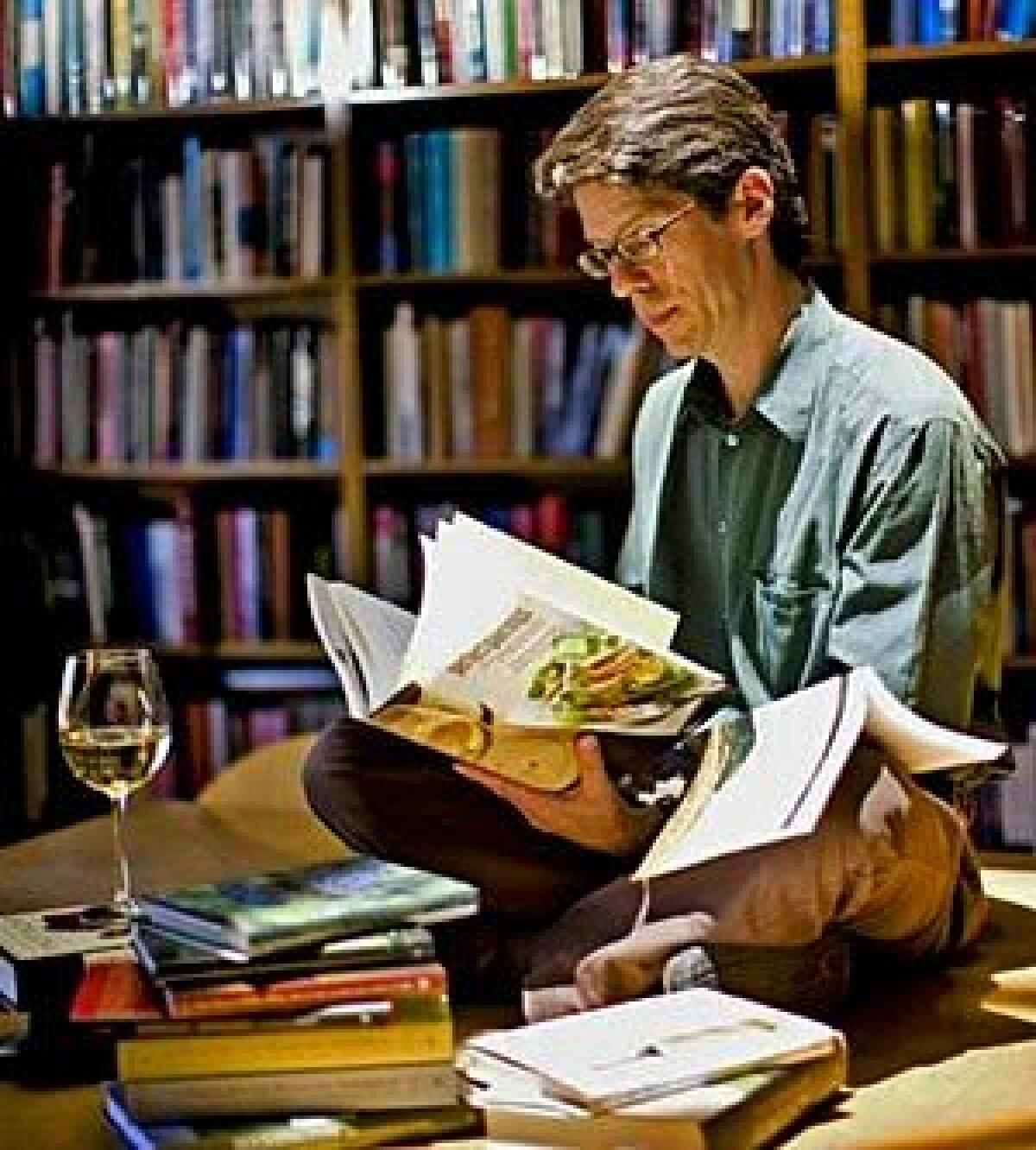UC Press publishes wine books to fill a gap

July 2, 2008
This month, University of California Press releases William A. Ausmus’ “Wines & Wineries of California’s Central Coast,” one of six wine books the Berkeley-based academic press will publish this year and the 23rd wine-focused book released by the press in the last five years.
The paperback guide is more ambitious than it looks at first glance, and publishing the wine guide to the region spotlighted by the movie “Sideways” is a bigger gamble than it might seem.
UC Press is gearing up its wine division just as commercial publishers are dropping back from the category, worried that competition for space on bookstore shelves is too intense.
The ebb and flow of the market is irrelevant to Blake Edgar, the UC Press acquisitions editor tapped five years ago to revive the wine category. The press has a mandate to publish books relevant to California and the western United States, and releasing new wine-related books is central to its mission. Regardless of the commercial potential, there are wine regions that have yet to be authoritatively documented and aspects of winemaking that demand fresh analysis because of new science.
“So much of this is timing. We’ve stepped in [to wine books] when there is a place for us,” says Sheila Levine, associate director and publisher of UC Press. “We’re building on our region, but taking a global approach.”
The largest and oldest university press west of the Mississippi River, UC Press publishes a minimum of 180 books a year. In 2003, it began to rebuild its reputation in the wine category -- after long ceding the scholarly end of the market to London-based publishers Mitchell Beazley and Oxford University Press -- by publishing serious fare for wine lovers.
This current list, which clearly reflects the choices made possible by the press’ nonprofit status, is “a broad exploration of wine,” Edgar says, for an “audience that is educated and curious.”
Since joining UC Press in 2000, Edgar has acquired new trade and scholarly books in the subjects of biology, anthropology and now wine. As an author and coauthor of magazine articles and nonfiction books (including “From Lucy to Language,” a New York Times notable book of 1996), Blake enjoys working with authors on manuscripts intended for a general readership.
When Edgar heard Ausmus’ story of arriving to teach communications at Cal Poly San Luis Obispo and discovering vineyards outside his office window but no guide to help him navigate the local wine region, he quickly greenlighted the book proposal.
Edgar was already negotiating with Wine Enthusiast contributing editor and Seattle Times columnist Paul Gregutt to write a critical evaluation of Washington state wines. That book, “Washington Wines & Wineries,” was released last October. The first printing of 5,000 copies sold out in a month, Gregutt says. The book is now in its fourth printing.
“It’s a good example of why UC Press will succeed,” he says. “They saw a gaping hole. There was no definitive book on Washington wine. And they filled it.”
Books delineating western U.S. wine regions are just a part of the territory. UC Press has published authoritative volumes on American wine including Thomas Pinney’s “A History of Wine in America,” and John Haeger’s “North American Pinot Noir,” for which a follow-up edition is due out later this year. Clive Coates’ “The Wines of Burgundy,” considered among the best books written on that region, is another 2008 release.
The just-break-even policy at the press allows Edgar to follow his interest in the science, history and politics of wine. The results can be mixed.
Jean-Robert Pitte’s “Bordeaux/Burgundy: A Vintage Rivalry” is nobody’s idea of beach reading. Few will have the patience to plow through the repetitive and unfocused prose to glean the slivers of insight the book offers into these regions.
Tyler Colman’s “Wine Politics: How Governments, Environmentalists, Mobsters, and Critics Influence the Wines We Drink” is a history of non-oenological influences on wine. It offers a helpful summation of certain French and American wine regulations, but it’s already out of date.
But Edgar hasn’t forgotten the more casual wine lover. Last year, UC Press released Steve Heimoff’s “New Classic Winemakers of California,” a collection of breezy question and answer sessions with some of America’s leading winemakers. Though the profiles can touch on esoteric winemaking issues, it’s a breezy read.
And the backlist title, “Perfect Pairings,” a guide to matching wines with meals by Evan Goldstein, is among the press’ most successful releases, having sold 27,000 copies so far since its release in 2006.
Scarce new wine books
MOST OF these titles would never be released by a commercial publisher. Even mainstream houses that have had wine-book hits such as Gotham Books had recently with Julia Flynn Siler’s “The House of Mondavi: The Rise and Fall of an American Wine Dynasty” -- which sold 100,000 hardcover and paperback copies -- are reluctant to publish additional books about wine or winemakers.
“A big run for a wine title is 10,000 copies -- too small to turn much of a profit,” says Bill Shinker, Gotham president and publisher. “There have been some big food books,” Shinker says, “but I don’t see the same trend with wine.”
Neither does Pam Krauss, executive editor at Clarkson Potter, a division of Crown Publishing. “Everyone has to eat, but not everyone has to drink wine,” she says. “We put our toe in this category cautiously. It’s hard to talk about wine without instantly making people’s eyes glaze over.”
True, most wine books don’t make money. But when one works, says Ten Speed Press acquisitions editor Aaron Wehner, it sells forever. Kermit Lynch’s “Adventures on the Wine Route: A Wine Buyer’s Tour of France,” for instance, he says, is in its 15th printing. Books by Jancis Robinson, Robert M. Parker and Karen MacNeil are evergreen. In the hunt for those magic titles, Wehner says he publishes one or two new wine books a year.
For decades, the dominant publisher of wine titles has been Mitchell Beazley in London, which publishes “The World Atlas of Wine” by Jancis Robinson and Hugh Johnson, Stephen Brook’s Bordeaux books, and John Radford’s “The New Spain,” among other authoritative titles. “Hugh Johnson’s Pocket Wine Book” published by Mitchell Beazley has sold 10 million copies. “The World Atlas of Wine” has sold 4 million copies.
Still, Mitchell Beazley publisher David Lamb says, the imprint is hesitant to release new titles. “We publish one stand-alone title [annually], which we aim to be a category killer in its genre,” Lamb wrote in an e-mail response to questions. This year, it will be “Heard It Through the Grapevine” by Matt Skinner, a guide aimed at younger wine drinkers.
The Mitchell Beazley Wine Library contains 20 titles that sell no more than a few hundred copies a year. “We battle to keep them in print,” he says. “We admire their scholarship.”
Oxford University Press is more cautious than UC Press when it comes to wine books. It released Jancis Robinson’s “The Oxford Companion to Wine,” which has sold more than 100,000 copies across three editions. But, beyond new editions of its flagship titles, Oxford publishes perhaps one new wine book a year, says Ben Keene, the acquisitions editor specializing in wine books.
In such a climate, as it strives to elevate its wine library, taking risks may be UC Press’ most potent edge.
More to Read
Sign up for our L.A. Times Plants newsletter
At the start of each month, get a roundup of upcoming plant-related activities and events in Southern California, along with links to tips and articles you may have missed.
You may occasionally receive promotional content from the Los Angeles Times.






